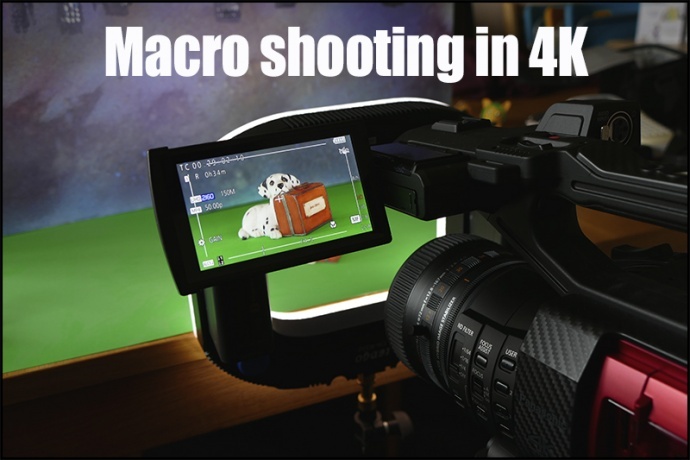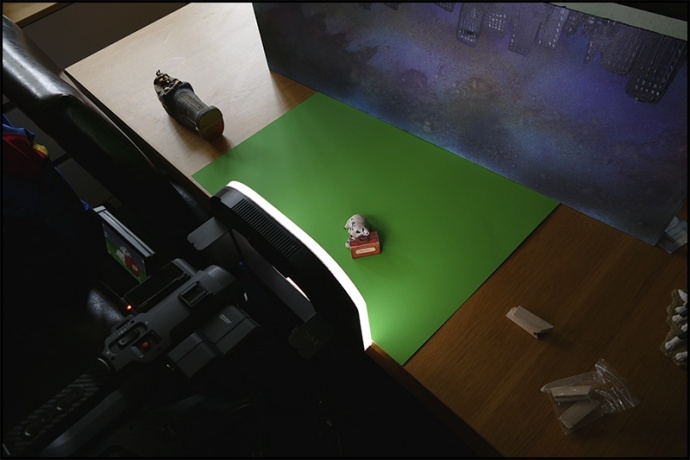微距下的Panasonic DVX200
译者按:最近开始了编译国外摄影师Blog日志的工作,可能还会有个别的翻译错误,以及理解上可能也会有些差异,像这篇还是挺好理解的。但愿将来编译能够越来越通顺和意义传达准确,谢谢啦;)

有关于松下DVX-200,一个伟大功能就是微距变焦,得益于为这台相机专门设计精湛的莱卡13倍4K光学变焦镜头。

这里是UHD16:9视频截图JPEG,拍摄场景文件5,在0dB,UHD 50P模式下。注意,如果是在25fps帧数下,图像就会像照片一样,但我更喜欢用150Mbps码流,而不是100Mpbs的25fps。

单光源是来自Datavision LEDGO R332 环形LED灯,在DVX200的正前方。我也尝试了定格和延时摄影,来记录得到完美的作品。

提醒一句,如果你有一台松下PX-270,它所用的电池为VW-VBD58,它和DVX200所用的电池是一样的。而另外一些人电池型号可能是HL-D54,它适用于AC-90和PX270,但并不适用于DVX200.

在DVX200手册中,它告诉我们,15.49像素的FHD进一步留下更多4.51MP而被证实运用的是Lumix GX8传感器,这点已经被其他用户怀疑过,我也是今天才发现这个以前的信息,它也包含了先前“GX8传感器”内容。
上面一段理解无能,原文为:
In the DVX-200 manual it tells us that FHD is 15.49 pixels leaving a further 4.51 MP margin confirming that the 200 is indeed sporting the Lumix GX8 sensor, this has been doubted by other readers. I only found this out today which is why I have also included this information in a previous “GX8 sensor” post
以及下面的一位网友留言:
2015年10月8日在上午12时57分
我想过一段时间,DVX-200必须和DMC-GX8使用相同(或非常接近)20.3万像素M4 / 3传感器。
在检查了DVX-200此前发布的数据之后,对我来说所包含的帮助显示在了之前的帖子信息上:
http://www.hdwarrior.co.uk/wp-content/uploads/2015/09/lens.jpg
值得注意的是在广角焦距上(35mm有效焦距相当于 12.8mm)从中我们可以计算出DCI-4K 24P的实际焦距系数UHD 25 / 30- 50 / 60p,UHD与FHD.
约为2.18的全高清裁切系数(28/12.8=~2.18)这是全高清中基本相同的,如GH4,相机拥有17.3mm宽,mM4/3大小的传感器。
然后我们可以意识到,对于DCI-4K 24P的系数,UHD 25 / 30p和UHD 50 / 60p都不同的计算方式,每个传感器的不同区域都会在不同情况下进行采样。
当DCI-4K(2.3倍)裁切系数和UHD 25 / 30P(2.4倍)相比于GH4,GH4的裁切系数(分别为2.5倍和2.6倍),实际上更低,因此表明,DVX-200必须从一个更大的物理区域对那些模式进行采样(更高的像素密度)传感器,采样(甚至超出)图像记录的视频分辨率。
而在UHD 50/60P模式下,2.9倍的裁切系数(37.2/12.8=~2.9)要求DVX200传感器的采样区域需要与100%的像素*像素读出3840*2160的像素(这与GH4在UHD和DCI-4K模式下传感器的采样方式一样)因为DVX200比GH4在物理区域上一样大的的传感器,但有着更高的像素密度(在100%像素*像素读出)这意味着更小的裁切系数,因此自然更佳。(UHD模式下GH4为2.6x,而UHD 50/60P模式下DVX200为2.9x)。
图像感应器尺寸:17.3 x13.0毫米(以4:3宽高比)
相机有效像素:20.30万像素
静止图像文件大小(像素):
[4:3] 5184×3888
[3:2] 5184×3456
[16:9] 5184×2920
全部传感器宽度= 5184像素超出17.3mm
UHD-4K(3840×2160)(16:9)以100%的像素*像素的裁切= 3840像素在度宽为12.81毫米的传感器上裁切
3840/5184 = 0.7407 (~74.1%)
17.3mmx 0.7407 =12.81mm
使用的传感器面积UHD-4K(16:9)= 12.81×7.21mm
帧对角线=14.7毫米
帧对角线作物因素:
(相对于35mm全帧[36x24mm]对角43.27毫米的):
43.27 / 14.7 = 2.94
松下等相机制造商使用帧对角线(=成像圈覆盖的传感器无论宽高比)裁切系数,但对于那些喜欢谁的(更形象)帧的水平方法这个例子是这样的:
帧的水平裁切系数:
(相对于35mm全帧[36x24mm]与36mm水平):
36 / 12.81 = 2.81
菲利普,如果你有机会来比较,我很想知道是否有在DVX-200的图像质量在全高清(采样来自传感器的分辨率),UHD 25 / 30P(采样来自传感器的分辨率)和UHD 50 / 60P(100%传感器的分辨率)的差别。在不同裁切因素将要求通过使用缩放均衡视场,但我怀疑编解码器的差别将会对上述有关的静态测试有着显着的影响。
在GH4的UHD图像(100%传感器的分辨率),是明显优于全高清(采样来自传感器的宽度的分辨率),即使双方只有全高清播放。只是想知道如果DVX-200能够采样适用于一个更好的工作,或者,最好还是在可能使用100%的像素模式输出?
译者理解:上面这位网友一定是资深用户,数据如此详细,但涉及到信息也都是基本常识,个人这方面知识还挺薄弱,只是了解个皮毛。但像如此认真的网友,相信一定会得到博主的重视,难道这不也该是国内器材论坛的气氛嘛~不光是论坛,做事的态度也值得学习啊~
There is a great macro zoom function on the Panasonic DVX-200 this is also helped by the superb 13x Leica 4K optical zoom lens made specially for this camera.
4K Timeline dog copy
Double click to see this JPEG in full UHD 16:9. Shot with Scene file 5, at 0dB, UHD 50p. Note. Some of you will tell me 25p would be fine for a still picture like this but I prefer to get extra bonus of 150Mbps rather than 100Mbps (25p).
Dog WS stage
The single light source is from one Datavision LEDGO R332 LED ring light in front of the DVX-200 lens. I also tried out the interval timer record which works flawlessly.
batt
A word of warning if you have a Panasonic PX-270 it comes with a VW-VBD58 battery pack which is the same battery that comes with the DVX-200. Some of you may also have the hahnel HL-D54 Lion battery used in the AC-90 and the PX270 but it won’t fit the DVX-200.
GX8 20MP
In the DVX-200 manual it tells us that FHD is 15.49 pixels leaving a further 4.51 MP margin confirming that the 200 is indeed sporting the Lumix GX8 sensor, this has been doubted by other readers. I only found this out today which is why I have also included this information in a previous “GX8 sensor” post.
1 comment on this post
Peter Loughran says:
October 8, 2015 at 12:57 am
I’ve thought for some time that the DVX-200 must use the same (or a VERY close relative) 20.3 Megapixel M4/3 sensor as used in the DMC-GX8.
After checking the (somewhat limited) previously released specifications of the DVX-200, what helped clinch it for me was the information contained in the DVX-200 lens data image you also showed in an earlier post:
http://www.hdwarrior.co.uk/wp-content/uploads/2015/09/lens.jpg
Of note are the quoted Wide Angle focal lengths (35mm equivalents relative to the actual 12.8mm of the lens) from which we can calculate the effective crop factors for the DCI-4K 24P, UHD 25/30P, UHD 50/60P and FHD.
The Full HD crop factor of 2.18 (28/12.8 = ~2.18) is essentially identical to the known Full HD crop factor of the GH4 and suggests that, like the GH4, the camera is down-sampling the image from the full 17.3mm width of the M4/3 sensor.
Then we can see that the crop factors for the DCI-4K 24P, UHD 25/30P and UHD 50/60P are all of different values so different areas of the sensor must be being sampled in each case.
The crop factors for the DCI-4K (2.3x) and UHD 25/30P (2.4x) are actually lower than the same figures for the GH4 (2.5x and 2.6x respectively) so indicate that the DVX-200 must be sampling those modes from a larger physical area of the (higher pixel density) sensor then down-sampling the (over-sampled) image to the recorded video resolutions.
In the UHD 50/60P mode, the crop factor of 2.9x (37.2/12.8 = ~2.9) suggests the DVX-200 is sampling an area of the sensor which corresponds to a 100% pixel-for-pixel readout of 3840×2160 pixels (in the same way as the GH4 samples from the sensor in its UHD and DCI-4K modes). Because the DVX-200 has a higher pixel density than the GH4 the physical area of the sensor used (at 100% pixel-for-pixel readout) will be smaller and the crop factor correspondingly greater (2.6x for UHD in the GH4, 2.9x for UHD 50/60P in the DVX-200).
Calculating the UHD (100% 3840×2160 pixel) crop factor if applied to the known DMC-GX8 sensor also gives a crop factor of ~2.9 (rounded from 2.94) as follows:
Image sensor size: 17.3 x 13.0 mm (in 4:3 aspect ratio)
Camera effective pixels: 20.30 Megapixels
Still Image File size (Pixels):
[4:3] 5184×3888
[3:2] 5184×3456
[16:9] 5184×2920
Full sensor width = 5184 pixels over 17.3mm
UHD-4K (3840×2160)(16:9) at 100% pixel-for-pixel crop = 3840 pixels over 12.81mm crop of sensor width
3840/5184 = 0.7407 (~74.1%)
17.3mm x 0.7407 = 12.81mm
Area of sensor used in UHD-4K (16:9) = 12.81×7.21mm
Frame Diagonal = 14.7mm
Frame Diagonal Crop Factor:
(relative to 35mm Full Frame [36x24mm] with diagonal of 43.27mm):
43.27/14.7 = 2.94
Panasonic and other camera manufacturers use Frame Diagonal (= image circle to cover sensor regardless of aspect ratio) crop factors but for those who prefer the (easier to visualise) Frame Horizontal method this example would look like this:
Frame Horizontal Crop Factor:
(relative to 35mm Full Frame [36x24mm] with horizontal of 36mm):
36/12.81 = 2.81
Philip, if you get the chance to compare, I’d be interested to know if there is any obvious difference in DVX-200 image quality when in Full HD (down-sampled from sensor resolution), UHD 25/30P (down-sampled from sensor resolution) and UHD 50/60P (100% sensor resolution). The differing crop factors would require equalising the field of view by using the zoom but I doubt the codec differences would have a noticeable effect on a static subject as above.
In the GH4 the UHD image (100% sensor resolution) is noticeably superior to the Full HD (down-sampled from sensor width resolution) even when both viewed at only Full HD playback. Just wondering if the DVX-200 is making a better job of down-sampling or if is still preferable to use the 100% pixel readout mode where possible?
原文地址:http://www.hdwarrior.co.uk/2015/10/07/a-macro-day-with-the-panasonic-dvx-200/

有关于松下DVX-200,一个伟大功能就是微距变焦,得益于为这台相机专门设计精湛的莱卡13倍4K光学变焦镜头。

这里是UHD16:9视频截图JPEG,拍摄场景文件5,在0dB,UHD 50P模式下。注意,如果是在25fps帧数下,图像就会像照片一样,但我更喜欢用150Mbps码流,而不是100Mpbs的25fps。

单光源是来自Datavision LEDGO R332 环形LED灯,在DVX200的正前方。我也尝试了定格和延时摄影,来记录得到完美的作品。

提醒一句,如果你有一台松下PX-270,它所用的电池为VW-VBD58,它和DVX200所用的电池是一样的。而另外一些人电池型号可能是HL-D54,它适用于AC-90和PX270,但并不适用于DVX200.

在DVX200手册中,它告诉我们,15.49像素的FHD进一步留下更多4.51MP而被证实运用的是Lumix GX8传感器,这点已经被其他用户怀疑过,我也是今天才发现这个以前的信息,它也包含了先前“GX8传感器”内容。
上面一段理解无能,原文为:
In the DVX-200 manual it tells us that FHD is 15.49 pixels leaving a further 4.51 MP margin confirming that the 200 is indeed sporting the Lumix GX8 sensor, this has been doubted by other readers. I only found this out today which is why I have also included this information in a previous “GX8 sensor” post
以及下面的一位网友留言:
2015年10月8日在上午12时57分
我想过一段时间,DVX-200必须和DMC-GX8使用相同(或非常接近)20.3万像素M4 / 3传感器。
在检查了DVX-200此前发布的数据之后,对我来说所包含的帮助显示在了之前的帖子信息上:
http://www.hdwarrior.co.uk/wp-content/uploads/2015/09/lens.jpg
值得注意的是在广角焦距上(35mm有效焦距相当于 12.8mm)从中我们可以计算出DCI-4K 24P的实际焦距系数UHD 25 / 30- 50 / 60p,UHD与FHD.
约为2.18的全高清裁切系数(28/12.8=~2.18)这是全高清中基本相同的,如GH4,相机拥有17.3mm宽,mM4/3大小的传感器。
然后我们可以意识到,对于DCI-4K 24P的系数,UHD 25 / 30p和UHD 50 / 60p都不同的计算方式,每个传感器的不同区域都会在不同情况下进行采样。
当DCI-4K(2.3倍)裁切系数和UHD 25 / 30P(2.4倍)相比于GH4,GH4的裁切系数(分别为2.5倍和2.6倍),实际上更低,因此表明,DVX-200必须从一个更大的物理区域对那些模式进行采样(更高的像素密度)传感器,采样(甚至超出)图像记录的视频分辨率。
而在UHD 50/60P模式下,2.9倍的裁切系数(37.2/12.8=~2.9)要求DVX200传感器的采样区域需要与100%的像素*像素读出3840*2160的像素(这与GH4在UHD和DCI-4K模式下传感器的采样方式一样)因为DVX200比GH4在物理区域上一样大的的传感器,但有着更高的像素密度(在100%像素*像素读出)这意味着更小的裁切系数,因此自然更佳。(UHD模式下GH4为2.6x,而UHD 50/60P模式下DVX200为2.9x)。
图像感应器尺寸:17.3 x13.0毫米(以4:3宽高比)
相机有效像素:20.30万像素
静止图像文件大小(像素):
[4:3] 5184×3888
[3:2] 5184×3456
[16:9] 5184×2920
全部传感器宽度= 5184像素超出17.3mm
UHD-4K(3840×2160)(16:9)以100%的像素*像素的裁切= 3840像素在度宽为12.81毫米的传感器上裁切
3840/5184 = 0.7407 (~74.1%)
17.3mmx 0.7407 =12.81mm
使用的传感器面积UHD-4K(16:9)= 12.81×7.21mm
帧对角线=14.7毫米
帧对角线作物因素:
(相对于35mm全帧[36x24mm]对角43.27毫米的):
43.27 / 14.7 = 2.94
松下等相机制造商使用帧对角线(=成像圈覆盖的传感器无论宽高比)裁切系数,但对于那些喜欢谁的(更形象)帧的水平方法这个例子是这样的:
帧的水平裁切系数:
(相对于35mm全帧[36x24mm]与36mm水平):
36 / 12.81 = 2.81
菲利普,如果你有机会来比较,我很想知道是否有在DVX-200的图像质量在全高清(采样来自传感器的分辨率),UHD 25 / 30P(采样来自传感器的分辨率)和UHD 50 / 60P(100%传感器的分辨率)的差别。在不同裁切因素将要求通过使用缩放均衡视场,但我怀疑编解码器的差别将会对上述有关的静态测试有着显着的影响。
在GH4的UHD图像(100%传感器的分辨率),是明显优于全高清(采样来自传感器的宽度的分辨率),即使双方只有全高清播放。只是想知道如果DVX-200能够采样适用于一个更好的工作,或者,最好还是在可能使用100%的像素模式输出?
译者理解:上面这位网友一定是资深用户,数据如此详细,但涉及到信息也都是基本常识,个人这方面知识还挺薄弱,只是了解个皮毛。但像如此认真的网友,相信一定会得到博主的重视,难道这不也该是国内器材论坛的气氛嘛~不光是论坛,做事的态度也值得学习啊~
There is a great macro zoom function on the Panasonic DVX-200 this is also helped by the superb 13x Leica 4K optical zoom lens made specially for this camera.
4K Timeline dog copy
Double click to see this JPEG in full UHD 16:9. Shot with Scene file 5, at 0dB, UHD 50p. Note. Some of you will tell me 25p would be fine for a still picture like this but I prefer to get extra bonus of 150Mbps rather than 100Mbps (25p).
Dog WS stage
The single light source is from one Datavision LEDGO R332 LED ring light in front of the DVX-200 lens. I also tried out the interval timer record which works flawlessly.
batt
A word of warning if you have a Panasonic PX-270 it comes with a VW-VBD58 battery pack which is the same battery that comes with the DVX-200. Some of you may also have the hahnel HL-D54 Lion battery used in the AC-90 and the PX270 but it won’t fit the DVX-200.
GX8 20MP
In the DVX-200 manual it tells us that FHD is 15.49 pixels leaving a further 4.51 MP margin confirming that the 200 is indeed sporting the Lumix GX8 sensor, this has been doubted by other readers. I only found this out today which is why I have also included this information in a previous “GX8 sensor” post.
1 comment on this post
Peter Loughran says:
October 8, 2015 at 12:57 am
I’ve thought for some time that the DVX-200 must use the same (or a VERY close relative) 20.3 Megapixel M4/3 sensor as used in the DMC-GX8.
After checking the (somewhat limited) previously released specifications of the DVX-200, what helped clinch it for me was the information contained in the DVX-200 lens data image you also showed in an earlier post:
http://www.hdwarrior.co.uk/wp-content/uploads/2015/09/lens.jpg
Of note are the quoted Wide Angle focal lengths (35mm equivalents relative to the actual 12.8mm of the lens) from which we can calculate the effective crop factors for the DCI-4K 24P, UHD 25/30P, UHD 50/60P and FHD.
The Full HD crop factor of 2.18 (28/12.8 = ~2.18) is essentially identical to the known Full HD crop factor of the GH4 and suggests that, like the GH4, the camera is down-sampling the image from the full 17.3mm width of the M4/3 sensor.
Then we can see that the crop factors for the DCI-4K 24P, UHD 25/30P and UHD 50/60P are all of different values so different areas of the sensor must be being sampled in each case.
The crop factors for the DCI-4K (2.3x) and UHD 25/30P (2.4x) are actually lower than the same figures for the GH4 (2.5x and 2.6x respectively) so indicate that the DVX-200 must be sampling those modes from a larger physical area of the (higher pixel density) sensor then down-sampling the (over-sampled) image to the recorded video resolutions.
In the UHD 50/60P mode, the crop factor of 2.9x (37.2/12.8 = ~2.9) suggests the DVX-200 is sampling an area of the sensor which corresponds to a 100% pixel-for-pixel readout of 3840×2160 pixels (in the same way as the GH4 samples from the sensor in its UHD and DCI-4K modes). Because the DVX-200 has a higher pixel density than the GH4 the physical area of the sensor used (at 100% pixel-for-pixel readout) will be smaller and the crop factor correspondingly greater (2.6x for UHD in the GH4, 2.9x for UHD 50/60P in the DVX-200).
Calculating the UHD (100% 3840×2160 pixel) crop factor if applied to the known DMC-GX8 sensor also gives a crop factor of ~2.9 (rounded from 2.94) as follows:
Image sensor size: 17.3 x 13.0 mm (in 4:3 aspect ratio)
Camera effective pixels: 20.30 Megapixels
Still Image File size (Pixels):
[4:3] 5184×3888
[3:2] 5184×3456
[16:9] 5184×2920
Full sensor width = 5184 pixels over 17.3mm
UHD-4K (3840×2160)(16:9) at 100% pixel-for-pixel crop = 3840 pixels over 12.81mm crop of sensor width
3840/5184 = 0.7407 (~74.1%)
17.3mm x 0.7407 = 12.81mm
Area of sensor used in UHD-4K (16:9) = 12.81×7.21mm
Frame Diagonal = 14.7mm
Frame Diagonal Crop Factor:
(relative to 35mm Full Frame [36x24mm] with diagonal of 43.27mm):
43.27/14.7 = 2.94
Panasonic and other camera manufacturers use Frame Diagonal (= image circle to cover sensor regardless of aspect ratio) crop factors but for those who prefer the (easier to visualise) Frame Horizontal method this example would look like this:
Frame Horizontal Crop Factor:
(relative to 35mm Full Frame [36x24mm] with horizontal of 36mm):
36/12.81 = 2.81
Philip, if you get the chance to compare, I’d be interested to know if there is any obvious difference in DVX-200 image quality when in Full HD (down-sampled from sensor resolution), UHD 25/30P (down-sampled from sensor resolution) and UHD 50/60P (100% sensor resolution). The differing crop factors would require equalising the field of view by using the zoom but I doubt the codec differences would have a noticeable effect on a static subject as above.
In the GH4 the UHD image (100% sensor resolution) is noticeably superior to the Full HD (down-sampled from sensor width resolution) even when both viewed at only Full HD playback. Just wondering if the DVX-200 is making a better job of down-sampling or if is still preferable to use the 100% pixel readout mode where possible?
原文地址:http://www.hdwarrior.co.uk/2015/10/07/a-macro-day-with-the-panasonic-dvx-200/
本文为作者 倪雷尔 分享,影视工业网鼓励从业者分享原创内容,影视工业网不会对原创文章作任何编辑!如作者有特别标注,请按作者说明转载,如无说明,则转载此文章须经得作者同意,并请附上出处(影视工业网)及本页链接。原文链接 https://cinehello.com/stream/70881
